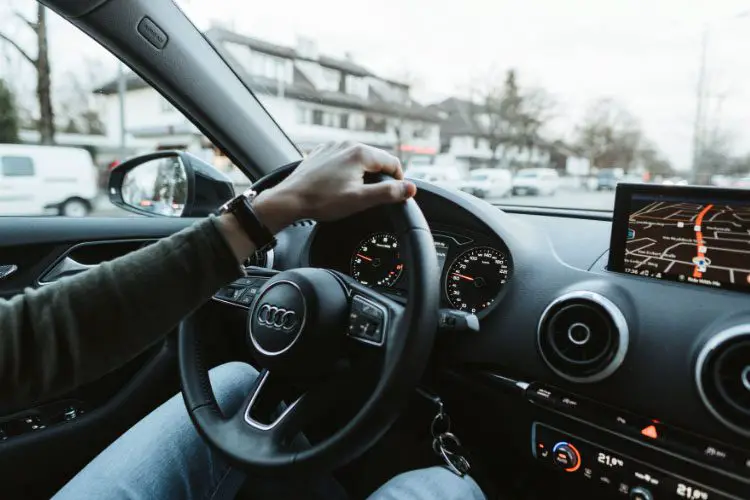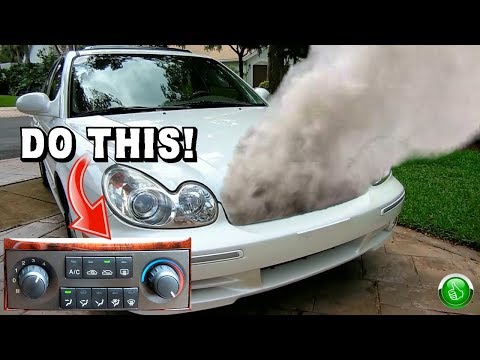When a car overheats while driving but cools at idle, is typically a cooling system trouble. However, whether it’s because of the cooling system or other possible reasons, you need to identify first.
So, what are the reasons a car overheats when driving but cools at idle? Low coolant levels, broken thermostats, clogged radiators, and so on are typically responsible for the issue. Thus, solving the problem as soon as possible is important for efficient vehicle performance.
In this article, we will discuss all the possible reasons that cause the problem. Not only that, but we will also talk about important factors regarding the topic. Stay tuned till the very end!
Problem-Solving Table Of Why Car Overheats When Driving But Cools Down At Idle

Here, we have tabulated the problems behind the car overheating issue and their solutions. This table will help you get a quick understanding of the topic.
| Reasons | Solutions |
| Low Coolant Levels | Fill the coolant up to the right levels |
| Clogged Radiators | Clean the radiator properly |
| Broken Water Pump | Repair or replace the pump |
| Stuck Open Thermostat | Install a new one in its place |
| Bad Radiator Fan | Repair the radiator fan or replace it |
It is important to diagnose the proper reasons behind the issue and solve it properly on time. This is because an overheating car loses efficiency and encounters several other problems.
Reasons Why Car Overheats When Driving But Cools At Idle

As we mentioned earlier, there are quite a few reasons why the problem occurs. Take a look at some of the common reasons and their fixes step by step.
1. Low Coolant Levels
Low coolant levels can cause the engine to overheat while driving. The reason behind this is that there is not enough coolant to absorb the heat generated by the engine. At idle, the engine generates less heat, so the coolant is able to keep the engine cool.

How To Fix It?
The problem has an extremely simple solution, and it is cost-efficient as well.
Step 1. Check the coolant level in the engine and make sure that it is at the right level.
Step 2. If the coolant is at a lower level than required, fill it properly up to the right mark.
2. Clogged Radiator
A clogged radiator is a common reason behind overheating when driving issue. Over time, the radiator accumulates dirt, debris, dust, and so on, which restricts the flow of coolant. This restriction causes the engine to overheat while driving but cool down at idle.

How To Fix It?
Step 1. Examine the radiator properly and see whether contaminants block it or not.
Step 2. In case of a blockage, flush the radiator to get rid of the dust, dirt, and so on accumulated inside with a cleaning solution.
You can also use specialized tools to clean the vehicle properly.
3. Broken Water Pump
The water pump is a necessary piece of equipment in a vehicle. It helps the coolant to circulate inside the system properly in order to cool down the vehicle. However, if the water pump is broken, it will not be able to circulate the coolant properly. This, in turn, will cause the vehicle to overheat.

How To Fix It?
Step 1. Inspect the water pump connected to the vehicle and ensure that it is working properly.
Step 2. If the water pump is malfunctioning, repair it and see whether it circulates the coolant efficiently.
You might also need to replace the pump if necessary.
3. Stuck Open Thermostat
A properly functional thermostat is highly important for a vehicle. If the thermostat is stuck open, it will not properly regulate the flow of coolant through the engine. And this will cause the engine to overheat while driving but cool down at idle.

How To Fix It?
Step 1. Test the thermostat attached to your vehicle and ensure that it is perfectly functional.
Step 2. Get the thermostat repaired properly and check whether it is working or not.
Step 3. Replace the component with a new one if needed.
4. Bad Radiator Fan
If the radiator fan is not functioning properly, it cannot cool down the engine while driving. And this will cause the engine to overheat. When the car is idle, the engine generates less heat, and the fan cools the engine down.

How To Fix It?
Step 1. Check the condition of the radiator fan and see whether it works or not.
Step 2. If the fan is clogged, clean the dirt, debris, etc., properly.
Step 3. Repair the fan or replace it with a new one if it is broken.
You can also check the wiring and make sure that there is no loose connection.
Bonus:
If you’re still left confused, follow this YouTube Video!
How To Test The Thermostat, Water Pump, And Radiator Fan?
Testing the components in the vehicle is important to diagnose the reason behind the problem. Let us take a look at how to test the thermostat, radiator fan, and water pump step by step.

Thermostat
Step 1. Remove the thermostat from the engine
Step 2. Place it in a pot of water on a stove. The thermostat should show the correct temperature as the water heats up.
Another way to test the thermostat is to check the operating temperature of the engine while it is running. If the temperature fails to reach the normal range, the thermostat may be faulty.

Water Pump
Step 1. Make sure that the drive belt is tight and not slipping.
Step 2. Remove the drive belt and spin the water pump pulley by hand. If it spins freely and smoothly, it is likely to function properly.
Another way to test the water pump is to check for coolant leaks around the pump.

Radiator Fan
Step 1. Check the fuses and relays associated with the fan
Step 2. Make sure they are functioning properly
You can also check the fan motor using a multimeter for continuity.
Accordingly, you can also test the fan by checking the fan while the engine is running at idle and at high speed. In case the fan is not running or moving too slowly, you can conclude that it is faulty.

Car Overheating Problem Prevention
Even though the issue of car overheating is quite common, vehicle owners can easily prevent it. Let us see how you can prevent the automobile from overheating when driving.

- Maintain the vehicle on a regular basis. Conduct proper inspections, repairs, replacements, and so on instead of ignoring the signs
- Use proper coolant and fill it up to the right level
- Frequently check the system for leaks and keep the radiator and other components clean
- Make sure to avoid roads with heavy traffic if possible. Stopping in traffic for long hours can put significant pressure on the engine

FAQs
Do you have more queries about this topic? Clear your confusion in these frequently asked questions!
Yes, it is possible if you can diagnose the problem and have proper vehicle knowledge. However, typically it is better to take the car to a professional mechanic.
Car overheating is quite common if the engine of your vehicle is damaged. However, the most common causes are low coolant levels, broken radiator fans, and so on.
Final Words
At the end of the guide, a car overheats while driving but cools at idle can be caused several issues within the cooling system. Now that you know the details of these problems and their solution, you can easily solve them.
Taking the vehicle to a professional mechanic is usually the best way of resolving the problem. Make sure that you take care of the car properly and ensure regular maintenance for efficient automobile performance.

